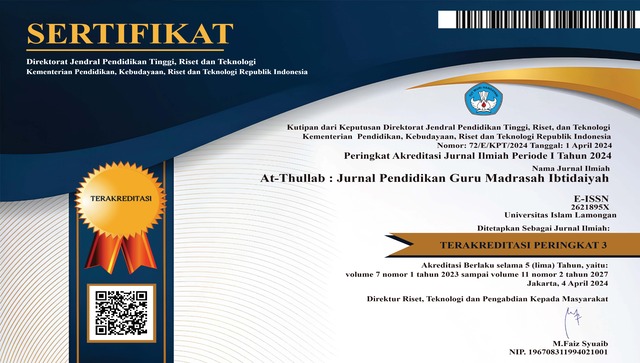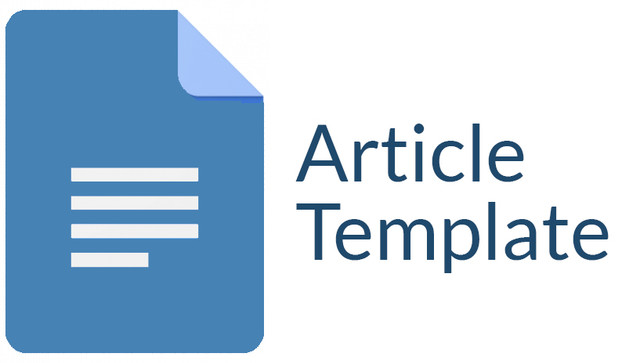Fostering Creative Thinking in Elementary Education: Integrating Social Inquiry Learning with Interactive Audio-Visual Media
DOI:
https://doi.org/10.30736/atl.v8i2.2220Keywords:
Social Inquiry Learning, Interactive Audio-Visual Media, Creative Thinking Skills, Elementary Education, Collaborative LearningAbstract
This study investigates the integration of social inquiry learning with interactive audio-visual media to enhance creative thinking among primary school students. The study used a qualitative case study method, focusing on a Grade 5 class at SDN Jajartunggal III, Surabaya. Data collection methods included participatory observations, semi-structured interviews with teachers, and student artifacts analysis. The study sought to understand how this instructional Model affects fluency, flexibility, originality, and elaboration in students’ creative thinking. The findings revealed that interactive media, such as digital storytelling and animated simulations, significantly increased student engagement and facilitated creative problem-solving. Students were able to delve deeper into social issues, collaborate more effectively, and express creative ideas more confidently. The study also underscored the critical role of teachers in facilitating this integrated approach, as their ability to balance structured guidance with open-ended inquiry was key to fostering creativity. In conclusion, this study contributes to understanding how combining social inquiry learning with audio-visual media can enhance creativity in elementary education. The results highlight the importance of teacher facilitation and suggest that further study should investigate the long-term impacts of this pedagogical approach across different educational contexts.
Downloads
References
Aguilar, D., & Pifarre Turmo, M. (2019). Promoting Social Creativity in Science Education With Digital Technology to Overcome Inequalities: A Scoping Review [Systematic Review]. Frontiers in Psychology, 10. https://doi.org/10.3389/fpsyg.2019.01474
Braun, V., & Clarke, V. (2006). Using thematic analysis in psychology. Qualitative study in Psychology, 3(2), 77-101. https://doi.org/10.1191/1478088706qp063oa
Chen, H. L., Huang, P. S., & Su, C. Y. (2021). Designing a vocational high school instructional program for enhancing creativity: Effects on creative thinking and group process analysis [Article]. Journal of study in Education Sciences, 66(3), 279-303. https://doi.org/10.6209/JORIES.202109_66(3).0009
Cook, H., Apps, T., Beckman, K., & Bennett, S. (2023). Digital competence for emergency remote teaching in higher education: understanding the present and anticipating the future. Educational technology research and development, 71(1), 7-32. https://doi.org/10.1007/s11423-023-10194-4
Creswell, J. W., & Poth, C. N. (2018). Qualitative Inquiry and Research Design: Choosing Among Five Approaches (4th ed.). Sage Publications.
Hakim, A. R., Ramdani, A., Setiadi, D., & Yustiqvar, M. (2023). Guided inquiry-based biology learning tools to improve students' creative thinking ability. AIP Conference Proceedings,
Harsa, W. P., Saragih, A., & Husein, R. (2020). The effect of audio visual and audio teaching media on the student’s listening achievement. The 5th Annual International Seminar on Transformative Education and Educational Leadership (AISTEEL 2020),
Hermawan, H., Mahardika, F., Darmayanti, I., Sumantri, R. B. B., Saputra, D. I. S., & Aminuddin, A. (2023). New Media as a Tools to Improve Creative Thinking: A Systematic Literature Review. Proceedings - 2023 IEEE 7th International Conference on Information Technology, Information Systems and Electrical Engineering, ICITISEE 2023,
Hsu, T.-C., Abelson, H., Lao, N., & Chen, S.-C. (2021). Is It Possible for Young Students to Learn the AI-STEAM Application with Experiential Learning? Sustainability, 13(19), 11114. https://www.mdpi.com/2071-1050/13/19/11114
Iqbal, Z., & Sami, A. (2020). Role of technology in science classrooms: An exploratory study of Pakistan [Article]. International Journal of Technology Enhanced Learning, 12(2), 115-126. https://doi.org/10.1504/IJTEL.2020.106281
Kolyvas, S., & Nikiforos, S. (2023). Technology and Creativity on early adolescence: A case study during COVID-19 pandemic. Current Psychology, 42(10), 8554-8561. https://doi.org/10.1007/s12144-021-02349-4
Liu, X., Nagai, Y., Yabuuchi, K., & Cui, X. (2021). Use interactive media to enhance creativity of designers by stimulating the senses in the context of art design education. Proceedings of the Design Society,
Monika, Bala, J., & Sunita. (2023). Scope and Challenges of Multimedia in Education Sector. International Journal for Multidisciplinary Research. https://doi.org/https://doi.org/10.36948/ijfmr.2023.v05i03.3868
Moula, Z. (2021). Academic perceptions of barriers and facilitators of creative pedagogies in higher education: A cross-cultural study between the UK and China [Article]. Thinking Skills and Creativity, 41, Article 100923. https://doi.org/10.1016/j.tsc.2021.100923
Mystakidis, S., Lambropoulos, N., Fardoun, H. M., & Alghazzawi, D. M. (2014). Playful blended digital storytelling in 3D Immersive eLearning Environments: A cost effective early literacy motivation method. ACM International Conference Proceeding Series,
Nurhayati, D. A. W., Putranto, A., Marwa, D. M., & Purwowidodo, A. (2020). Effect of Thinking Skill-Based Inquiry Learning Method on Learning Outcomes of Social Studies: A Quasi-Experimental Study on Grade VIII Students of MTSN 6 Tulungagung. IOP Conference Series: Earth and Environmental Science,
Pedersen, C., Aagaard, T., Daus, S., Nagel, I., Amdam, S. H., Vika, K. S., Røkenes, F. M., & Andreasen, J. K. (2024). Profiling teacher educators’ strategies for professional digital competence development. Teachers and Teaching, 30(4), 417-436. https://doi.org/10.1080/13540602.2024.2336612
Popp, J. S., & Goldman, S. R. (2016). Knowledge building in teacher professional learning communities: Focus of meeting matters. Teaching and Teacher Education, 59, 347-359. https://doi.org/https://doi.org/10.1016/j.tate.2016.06.007
Putri, J. A., Marsuki, M. F., Hamimi, E., & Fitriyah, I. J. (2023). Development of STEM-based animation interactive multimedia with feedback to improve students' creative thinking ability on motion topic. AIP Conference Proceedings,
Ramesh, S. (2024). The Effects of Parental Involvement on Student Academic Success. Global International Research Thoughts, 12(1), 43-48. https://doi.org/10.36676/girt.v12.i1.111
Raymundo, M. R. D. R. (2020). Fostering creativity through online creative collaborative group projects. Asian Association of Open Universities Journal, 15(1), 97-113. https://doi.org/10.1108/AAOUJ-10-2019-0048
Reed, C. L., Hagen, E., Bukach, C. M., & Couperus, J. W. (2022). Effectiveness of Undergraduate-Generated Animations: Increasing Comprehension and Engagement for Neuroscience Majors and Non-Majors. Teaching of Psychology, 49(4), 356-368. https://doi.org/10.1177/00986283211023061
Rosnawati, R., & Ardeniyansah, A. (2018). Implementation of Problem-Based Learning in terms of Student Mathematical Creative Thinking. Journal of Physics: Conference Series,
Sarnita, F., Irawan, A., Prayogi, S., & Asy'Ari, M. (2021). The effectiveness of guided inquiry learning tools in increasing students' activities and creative thinking skills. Journal of Physics: Conference Series,
Sastradika, D., & Defrianti, D. (2020). Development of creative thinking skills through STEM-based instruction in senior high school student. Journal of Physics: Conference Series,
Sefein, M. F., Zaigham, M. T., Idrees, Z., & Shahzil, M. (2024). Pedagogical practices that enhance medical students' capacity for creative thought: A qualitative study [Article]. Journal of Medical Education Development, 17(53), 1-8. https://www.scopus.com/inward/record.uri?eid=2-s2.0-85184274681&partnerID=40&md5=642e00ae043699ef65b24ce71c83f953
Shaik, N. (2023). Transforming Teaching and Learning in Early Childhood Care and Education During COVID-19 in a Poor Community of the Cape Flats, South Africa. Early Childhood Education Journal, 51(5), 791-800. https://doi.org/10.1007/s10643-022-01329-y
Sweller, J., van Merriënboer, J. J. G., & Paas, F. (2019). Cognitive Architecture and Instructional Design: 20 Years Later. Educational Psychology Review, 31(2), 261-292. https://doi.org/10.1007/s10648-019-09465-5
Tawil, M., & Dahlan, A. (2021). Application of Interactive Audio Visual Media to Improve Students' Creative Thinking Skill. Journal of Physics: Conference Series,
Traynor, K. (2020). Student Production of Pencasting E-Learning Videos: What Drives Engagement? International Journal of Management and Applied Research, 7(3), 319-339.
Trisnayanti, Y., Sunarno, W., & Masykuri, M. (2020). Creative thinking profile of junior high school students on learning science. Journal of Physics: Conference Series,
Vilarinho-Pereira, D. R., & Fleith, D. d. S. (2020). Creative use of information and communication technologies according to university professors and students. Estudos de Psicologia (Campinas), 38, e190164.
Yang, H., Cai, M., Diao, Y., Liu, R., Liu, L., & Xiang, Q. (2023). How does interactive virtual reality enhance learning outcomes via emotional experiences? A structural equation modeling approach [Original Research]. Frontiers in Psychology, 13. https://doi.org/10.3389/fpsyg.2022.1081372
Yin, R. K. (2014). Case Study Research Design and Methods (5th ed.). Sage.
Zhanqiang, M. (2023). Strategies for Cultivating Creative Thinking Ability of Students Majoring in Educational Technology. nature, 6(19), 62-66.
Downloads
Published
How to Cite
Issue
Section
License
Copyright (c) 2025 Reza Syehma Bahtiar, Jarmani, Ellena Aurellia Putri, Salwa Rizky Aulia, and Rizky Widyaningrum

This work is licensed under a Creative Commons Attribution-ShareAlike 4.0 International License.
Authors who publish with this journal agree to the following terms:
The journal allow the authors to hold the copyright without restrictions and allow the authors to retain publishing rights without restrictions. Authors retain copyright and grant the journal right of first publication with the work simultaneously licensed under a Creative Commons Attribution-ShareAlike 4.0 International License. that allows others to share the work with an acknowledgement of the work's authorship and initial publication in this journal.
Authors are able to enter into separate, additional contractual arrangements for the non-exclusive distribution of the journal's published version of the work (e.g., post it to an institutional repository or publish it in a book), with an acknowledgement of its initial publication in this journal.
Authors are permitted and encouraged to post their work online (e.g., in institutional repositories or on their website) prior to and during the submission process, as it can lead to productive exchanges, as well as earlier and greater citation of published work (See The Effect of Open Access).
The journal allows third parties (readers, researchers, and others) to share and adapt the material in line with the license. In addition, the material must be given appropriate credit, provided with a link to the license, and indicate if changes were made. If authors remix, transform, or build upon the material, they must distribute their contributions under the same license as the original.













